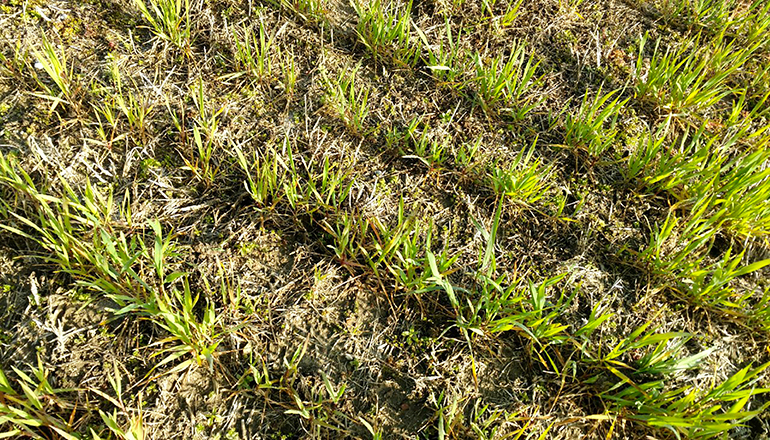April’s cold start in Missouri has limited fieldwork and delayed planting for farmers and gardeners.
The persistent cold “was nothing short of amazing,” said University of Missouri Extension climatologist Pat Guinan.
Many parts of the state, especially the northern half, averaged more than 15 degrees below normal for the first 10 days of April. Some locations experienced below-freezing minimum temperatures for nine or 10 consecutive days. For many communities, including Columbia, it will likely rank as the coldest first 10 days of April on record. Records date back to 1895.
A large pool of unusually cold air, centered over Hudson Bay, has been sitting and spinning over the region the past couple of weeks, sending shots of arctic air from Canada into the middle part of the United States.
“It’s hard to believe, but we’re on pace for experiencing the coldest April on record for Missouri,” said Guinan. The current record was set in April 1907, when the statewide average monthly temperature was 47.2 degrees—8 degrees below normal.
Very little corn planted; wait for warmer soils
Corn planting, hampered by unprecedented subfreezing temperatures and measurable snowfall, remains at only 1 percent, according to an April 8 USDA National Agricultural Statistics Service report. This pales in comparison to the four-year average of 7 percent. USDA reported only 1.5 days suitable for fieldwork in the first week of April.
But there is still plenty of time to plant corn, said MU Extension corn specialist Greg Luce. Wait until the soil warms. Planting now would result in low yields.
The temperature of the water that corn first takes in, or imbibes, is critical. The imbibition of cold water disrupts the reorganization of cells during rehydration and can result in loss of seed vigor or seed death.
The most critical time for imbibition is within 24 hours of planting. Chilling effects are worst when seeds go into soils 50 degrees or colder, compared to planting into warmer soils followed by a drop in temperature, Luce says.
Sprouted corn generally withstands a frost or freezing conditions because its growing point is beneath the soil. Temperatures of 28-32 degrees can damage, but temperatures below 28 degrees become lethal.
If you had a freeze, wait for a few days to look for damage. “Not all freeze injury is lethal,” said Luce.
Late freeze concerns exist in southern Mo. wheat
Concerns about Missouri’s wheat crop grow as freezing temperatures continued last week. USDA said 58 percent of the state’s wheat crop is in fair to very poor condition.
Winterkill is uncommon but not unheard of in Missouri. Freeze injury in wheat depends on the wheat’s development stage and how long the freeze lasts. Shallow planting also increases chances of injury. Look at roots of several affected plants for new root growth. Thin stands may require replanting.
Most wheat in northern Missouri is not jointed yet and has tolerated freezing temperatures, said Luce.
Wheat in southern Missouri faces the most danger. MU Extension agronomist Jill Scheidt said the MU Commercial Agriculture weather station in Lamar reported the 2-inch bare soil temperature at 35 degrees at 8:30 a.m. on April 4.
She said some earlier-planted wheat is jointing in southwestern Missouri, and later-planted wheat is still tillering. Scheidt has not seen damage yet, but she continues to look at corn and wheat fields. She said symptoms of damage include chlorosis, burnt leaf tips, silage odor and a blue cast to fields.
MU Extension agronomy specialist Tim Schnakenberg in Galena said a dry fall gave the wheat crop a slow start. “That, along with a cold winter and spring, has impacted the crop this year,” he said. “I know of some fields that were planted late and shallow into dry soil that are experiencing winter injury this year. They may survive but they are experiencing a slow start.”
In Bootheel counties, most wheat is at Feekes 7 (second node) and near Feekes 8 (flag leaf). Wheat freeze injury occurs at those stages when temperatures drop to 28 degrees or lower for two or more hours.
Monitor wheat injury several days after the freezing event says MU Extension field crops pathologist Kaitlyn Bissonnette. Split stems and look at heads for damage.
For more information on how to check for damage, see the article “Understanding Wheat Growth Stages for Estimating Wheat Freeze Injury” click on this link.
Low temperatures raise disease concerns
Bissonnette said freezing temperatures and prolonged moisture set the stage for seedling diseases in corn. This is especially true when germinating seeds or seedlings are damaged early in the growing season. Damage can allow disease-causing pathogens to infiltrate the plant.
The danger is worst when cold and wet conditions last for several weeks. Pythium, especially, likes wet soil around 50 degrees. If ideal conditions for infection persist, Pythium can infect growing seedlings even when seed treatments are applied.
Short hay supplies trouble cattle producers
USDA rated 77 percent of Missouri’s pastures in fair to very poor condition. Short hay supplies troubled cattle producers, with USDA reporting 36 percent of the state in short supply and another 9 percent in very short supply.
Schnakenberg said several cattle producers in southwestern Missouri need forage soon. One Barry County producer cut alfalfa two to three weeks earlier than normal because he ran out of hay to feed his herd, Schnakenberg said.
Southwestern Missouri forage growers already faced short supplies before lower temperatures hit, he said. New orchardgrass, fescue, ryegrass, wheat, rye and other cool-season forages did not survive on several farms due to the dry fall.
MU Extension livestock specialist Eldon Cole said pasture growth in the Mount Vernon area is “at a standstill.”







